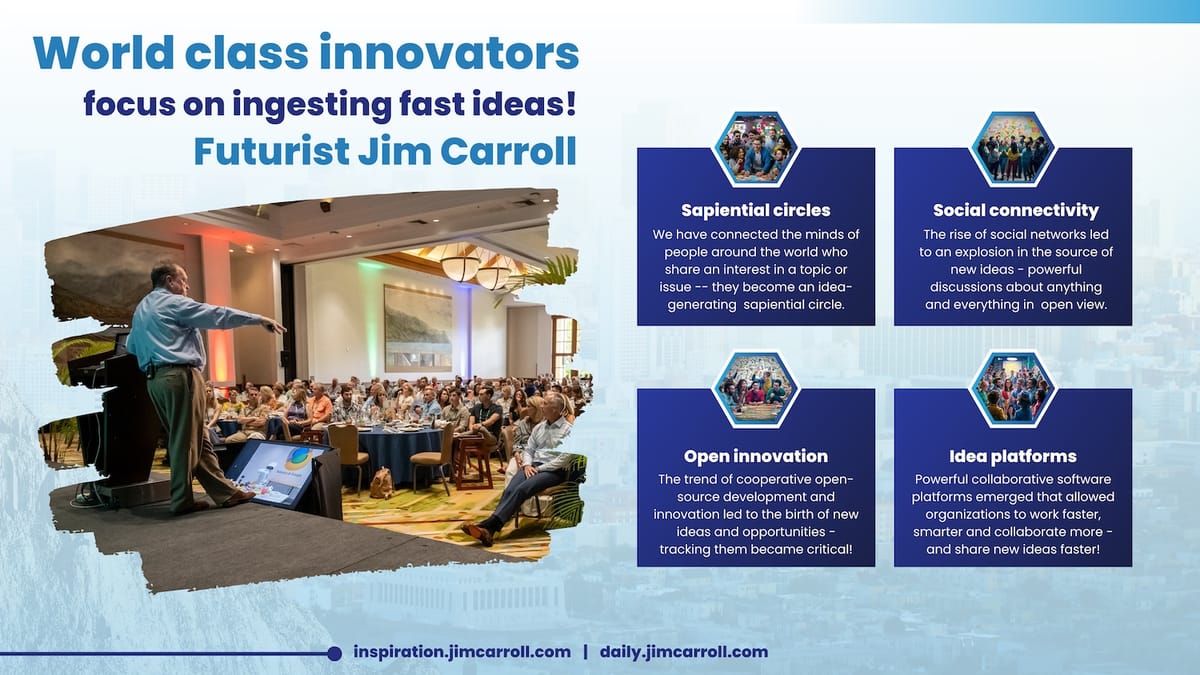"World class innovators focus on ingesting fast ideas" - Futurist Jim Carroll
Futurist Jim Carroll is running his Daily Inspiration series for the weeks of March 11/18 on the theme of “What is it that World Class Innovators Do That Others Don’t Do?” The leadership ideas are based on an original keynote he gave early in 2009 after a client asked him to identify these issues. He developed this carefully curated list based on 15 years of observations of how his global clients responded to fast-paced change.
An idea on its own is just an idea. Shared ideas are different - they accelerate innovation through faster discovery of opportunities! The fact is, if you have an idea and I have an idea, we have two ideas. If we share those ideas, we have something powerful! And the fact is, we can never be too short of great ideas. In that context, world-class innovators recognize that ideas are their most powerful asset, knowing that the smallest of shared ideas can become the most powerful opportunity.

When compiling my list of world-class innovations was this: world-class innovators were becoming relentlessly focused on doubling down on their ability to share ideas, chase ideas, find ideas, develop ideas, and internalize ideas. It seemed they came to realize that ideas were becoming the new currency of success - and in that context, the convergence of a variety of trends suddenly allowed organizations to accelerate their 'idea machines,' and hence, accelerate their capabilities for innovative thinking. Four key trends were underway.
- Sapiential circles: We have connected the minds of people around the world who share an interest in a topic or issue -- they become an idea-generating sapiential circle.
- Social connectivity: The rise of social networks led to an explosion in the source of new ideas - powerful discussions about anything and everything in open view.
- Open innovation: The trend of cooperative open-source development and other innovations led to the birth of new ideas and opportunities - tracking them became critical!
- Idea platforms: Powerful collaborative software platforms emerged that allowed organizations to work faster, smarter, and collaborate more - and share new ideas faster!
Suddenly, there were some increasingly powerful tools and idea machines available all over the place - and world-class innovators were rapidly aligning and adapting to them, recognizing they would provide a path to the future of innovative thinking.

Sapiential circles
One of the most profound of these trends had to do with the rise of "ever-growing sapiential circles" - a core trend that is driving rapid knowledge growth, and which is having a huge impact on idea sharing. The phrase comes from Warren Bennis, a distinguished professor at Southern California's Marshall School of Business -- he was referring to how the knowledge of a group tended to increase exponentially as new members were added to the group. What we are witnessing in the world today is a dramatic increase in our human sapiential circles as a result of global connectivity.
Quite simply, we have connected the minds of people around the world who share an interest in a topic or issue – they become a sapiential circle. The result is dramatic – for example, the amount of medical knowledge used to double every eight years but now doubles every 78 days; it is said that half of what an engineering student learns in their first year is obsolete or revised by the time they graduate because new engineering knowledge is shared so quickly; discoveries now occur quicker simply because like minds are connecting quicker.

Social connectivity
The explosion in the growth of social networks is both good and bad. They're massively destructive when it comes to social order, politics, personal ethical behavior, and more. yet at the same time, they are an invaluable source of idea insight. Customers are talking about products and services in the open, providing a powerful feedback mechanism. People share concepts ideas and information quickly and openly, allowing news ideas to bubble and then explode into global view. Companies can launch new ideas and instantly gauge potential reactions, and as a result, change their future trajectory faster. So many things happen all at once that quite simply, social networks lead to the future happening all at once, everywhere, all the time.
Open innovation
The trend towards open software as embodied by the Linux operating system defined the future of many industries, with the idea that open and shared research and development could provide a better product or service. Today, everything from farm tractors to home automation technology to energy microgrids is being impacted by open source ideas and open innovation - providing a powerful source of innovation ideas for any world-class innovator that chooses to plug in, tune in, and listen and participate in the development.
Idea platforms
In the early days of collaboration, organizations were using software like Lotus Notes, Microsoft Sharepoint, Skype, and Google Docs to share ideas and information. Today, software like Slack and Teams allows organizations to collaborate and share information faster; GitHub accelerates software development through collaborative development; Zoom allows massive interpersonal video-based collaboration. World-class innovators adapted and aligned to the use of these types of platforms early and often, knowing that a solid foundation for idea sharing was a solid foundation for faster innovation.

Take all of these trends and add them together, and it's quite clear that we are in a different world with fast ideas. Quite simply, world-class innovators learned early on, and know to this day, that the ability to create and nurture a culture, foundation, platform, and methodology for idea generation, sharing, and listening to these fast ideas would be fundamental to their future innovation success!
Fast ideas matter. Capturing them, nurturing them, sharing them, and learning from them matters more!
(Note: The images for this post were generated through a text-to-image AI tool. The arrival of AI will accelerate idea sharing even faster than before, and world-class innovators are already aligning with this reality.)
From 1985 to 1989, Futurist Jim Carroll participated in the development of a sophisticated collaborative internal idea machine for a global organization. They didn't understand the power of what he was unleashing, and so he bailed out of the corporate world to pursue these ideas on his own. The concepts developed in that project 40 years ago are in widespread use in the corporate world today.

